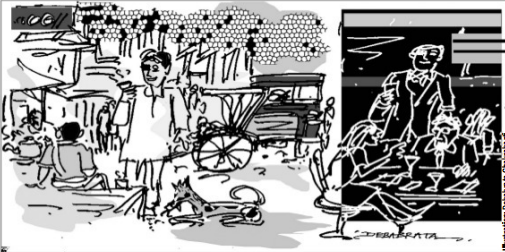City sizzles as Met dept extends heatwave alert
After sizzling at the highest day temperatures today, citizens of south Bengal, including Kolkata could face harsher days with the probability of temperature going up in the next few days.

For me there are two Kolkatas. The Kolkata I lived in thirty years ago and the Kolkata I now visit. In fact, the Kolkata I grew up in had a different name, Calcutta. Thirty years I walked its winding streets, drank its sweet milky tea and breathed its acetic air, happily and with gusto.
I lived in succession in Mechua Bazar, College Street, Ballygunj and Alipore – the first two in modest areas, and the last two, especially the last, in elite environs. Even when we lived in a run-down neighborhood, we had decent digs with functional furniture, and I always had a room of my own. So I could be by myself, read endless books in preferred isolation and listen to popular music and dream dreams.
Modest barrios have their benefits. It was the only time in my life I got to know slum kids as I played soccer with them and they treated me as equals, without distance or deference.
Advertisement
Thanks to my parents, who had a large circle of friends, I had a vast assortment of kids as friends, from the rambunctious child of a Scottish professor to a quiet but mischievous neighbourhood girl who spoke little but wrote me long and suggestive notes.
Our living room was curiously egalitarian: father wanted us kids to sit with adults and discuss whatever caught our fancy, even the multiple affairs of a Hollywood star du jour.
I fondly remember a Turkish journalist who stayed with us and taught mother how to make lamb delicacies, and a Japanese scholar who sang hosannas of Sushi and helped an Indian boy overcome his natural distrust of uncooked pesce. Unencumbered by the rules of hygiene, I ate with friends whatever street vendors dished out, in miraculous triumph over intestinal disorder.
I went walking everywhere, taking a bus only when the few coins in my pockets permitted the luxury. It didn’t seem arduous or unpleasant at all, and I saw things you see only when you are not whizzing past in a car. You saw every pedestrian, every beggar, every fruit seller, every rickshawpuller with his lined, sweatsoaked face. On Kolkata’s crowded roads your shoulders touched that of other passers-by; you had to be aware of the people, men or women, tall or short, old or young, that lived around you.When I came out of the university and took a job with an affluent corporation, I was transported overnight into another world. I got to see the elite clubs, the fancier restaurants and the night life of the well-heeled, especially the movie stars for whom I did an occasional stint on scripts.
It was, however, to the credit of Kolkata that it had bistros and coffee houses where the different worlds intermingled. Politicos and professors, reporters and policemen, executives and clerks, all talked, argued, analyzed, discussed, fought and made up. Kolkata was breathlessly alive on the streets and in the cafés.
After decades overseas in different continents, now that I live in the west, I make an annual pilgrimage to Kolkata, to see friends and to renew my link with a city I don’t want to be estranged from. It is quite a different Kolkata I visit.
A mammoth, modern airport beckons you. The roads are better, major street corners have become flyovers and the cars bear well known brand names. These advantages are balanced by a fierce flow of traffic and a swollen and careless army of pedestrians. Many old houses, even the ones I knew and loved, have yielded place to large shapeless structures.
Some shops, run by family businesses I once knew, still exist, but several have ceded ground to large shopping malls that are impressive but depressingly impersonal. The city has a different look – and a different price.
The last pair of shoes I bought when I lived there was for thirty rupees; when I came on a World Bank mission twenty years ago I paid three hundred for a comparable pair; now it costs three thousand.
A breathtaking variety of cuisine, Indian and Indianized western food, offers the gourmand a tantalizing temptation. Friends invite me to elite clubs, still bastions of peace and grace, and the service is jaw-dropping.
I don’t walk as much as I used to, though I would love to: the sidewalks are cracked and crowded, not the least because vendors have misappropriated a slice. Walking in the dusk, with the breeze in my face, feels oddly nostalgic, and, when I get lost, people on the street seem strangely solicitous to help me regain my bearing. One or two will even walk several yards to show me the correct turn.
That, to me, is quintessential Kolkata. Other things change, but remarkably the people haven’t changed all that much. They are busier, harried by demanding employers, inept banks and disorderly hospitals. Yet they defiantly retain some of their pristine virtues. They are helpful. They are warm. They are companionable.
They talk, express, exult and pull no punches to tell you what they think of the government, the city, the people around them, and their own life. They are voluble, candid and lively. They are exactly as I remember them and exactly as I want them to be. Maudlin as it sounds: I can get far, very far, out of Kolkata, I can’t get Kolkata out of me.
The writer is a Washington-based international development advisor and had worked with the World Bank. He can be reached at mnandy@gmail.com
Advertisement